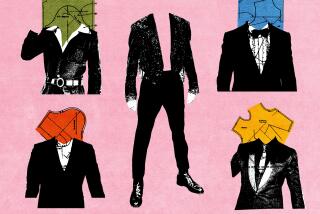Gary’s Tux Chain Is Finding It’s Better Suited to Rentals
- Share via
Every year about this time, as high school students’ thoughts turn from books and exams to graduation parties and days at the beach, Gary’s Tux Shops gears up for its busiest season.
Only during a seven-week period beginning in late April does the Van Nuys company’s plant maintain a double shift--cleaning, pressing and sorting thousands of jackets, cummerbunds and trousers in preparation for that adolescent rite of spring: The Prom.
The Gary’s organization rents and sells more tuxedos than anyone else in Southern California. Through its 18 retail outlets, most in Los Angeles and San Diego, along with 500 affiliated men’s clothing stores and bridal shops in California, Arizona and Nevada, the company circulates an inventory of more than 22,000 tuxedos. Proms actually account for only 10% of the company’s annual revenue. Weddings, which in the Sun Belt are spread fairly evenly throughout the year, make up 80%. But the flood of proms in such a short period sends the company’s dry-cleaning operation into a tizzy.
The problem is that the same customers who demand crisp, new-looking tuxedos often abuse them, said Gary Brill, 44, president and sole owner of Gary’s Cos., parent of both the retail chain and Gary’s Formal Wear, the company’s wholesale arm.
“People tell jokes about their rented tuxes,” Brill said. “It’s an uphill battle trying to overcome that.”
Brill cites horror stories of tuxes that get torn in limousine doors or end up soaked in swimming pools. He winces when talking about cigarette burns and stains from spilled champagne and flying bowls of hollandaise sauce.
But the tuxedo rental business is in Brill’s blood. His grandfather, Samuel, first opened a formal wear shop in 1917 at the corner of 3rd and Spring streets in downtown Los Angeles. His father, Morton, got into the business with a store in Hollywood in 1933.
Morton Brill, who died six years ago, opened the first Gary’s store in 1947, naming it after his then-5-year-old son. Thirteen years later, after a semester of accounting at Los Angeles City College, Gary Brill started working for the company full time.
Bought San Diego Chain
“It’s the thing I know best,” he said. “So here I am.”
Until a few years ago, the company made most of its money through tuxedo wholesaling. But in 1982, when Gary’s owned only four retail outlets, the company bought the 14-store Bob Coffman chain based in San Diego.
Company-owned stores now account for about 50% of Gary’s rentals and 70% of its revenue, which totals from $5 million to $7 million annually, Brill said. The nation’s biggest tuxedo retailer, Chicago-based Gingiss International, has annual sales in the neighborhood of $50 million from 235 franchise stores in 37 states, including California.
Renting a tuxedo from one of Gary’s shops costs between $45 and $69.50 for an evening. That includes a shirt, bow tie, cummerbund or vest and the jacket and trousers. Shoes cost an extra $8.
A typical tuxedo can be rented between 30 and 50 times, Brill said.
He said he recommends that customers planning to dress formally more than three times a year buy a tuxedo instead of rent. They retail at Gary’s own stores for between $200 and $600. Tuxedo sales account for between 15% and 18% of the company’s revenue, Brill said.
The clothing stores affiliated with Gary’s do not stock tuxes. Instead, they keep Gary’s catalogues on hand for customers to make selections.
Gary’s employs about 140 people, half of whom work in the dry-cleaning and packaging facilities. About 50 work in the stores and another 15 work in administration at the company’s headquarters.
Tuxedo rentals, a $600-million business in the United States last year, have been growing at more than 10% annually, according to the New York-based American Formalwear Assn. The group attributes the trend to more formal weddings, better prom attendance and to more black-tie business functions.
Changing tuxedo fashions also have boosted sales. In the late 1960s and early 1970s, the industry brought out flashy designs and colors to counter the business-dampening trend toward less formal dress.
Now, the trend is simply toward black and white, and naturally enough Brill attributes the change to a new conservatism born of the Reagan Administration.
Brill says his most popular line this year, made by Philadelphia-based After Six, the largest U.S. formal wear manufacturer, is named for the “Miami Vice” television series. Don Johnson, who stars in the program, models the simple, ventless white tux with pleated trousers in the Gary’s catalogue.
Bucking Fads
Joel Gingiss, president of Gingiss International, said the conservative trend, even in designer fashions, has come because people have realized that passing fads don’t hold up well in photographs.
“You have to know the difference between a costume and a tuxedo,” Gingiss said.
Actually, the tuxedo was a radical departure from standard formal wear when it debuted at the Tuxedo Club in Tuxedo Park, N.Y., on a breezy night in October, 1886. The tail-less coat and black tie instead of the standard tails and white tie virtually scandalized the tony community 40 miles northwest of New York City. A society columnist at the time dubbed it more appropriate for a “royal footman.”
More to Read
Inside the business of entertainment
The Wide Shot brings you news, analysis and insights on everything from streaming wars to production — and what it all means for the future.
You may occasionally receive promotional content from the Los Angeles Times.










